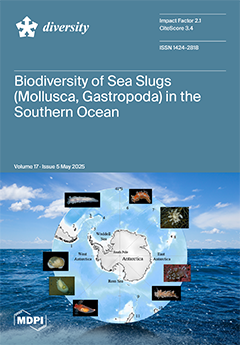This study examines the phytocenotic, phenotypic, phytochemical, antioxidant, and toxic effects of four geographically distinct populations of the traditionally used plant species
Adonis volgensis Steven ex DC. from Central and Northern Kazakhstan. These populations, found in diverse habitats such as steppe-like forest edges
[...] Read more.
This study examines the phytocenotic, phenotypic, phytochemical, antioxidant, and toxic effects of four geographically distinct populations of the traditionally used plant species
Adonis volgensis Steven ex DC. from Central and Northern Kazakhstan. These populations, found in diverse habitats such as steppe-like forest edges and moist plains, coexist with species like
Achillea nobilis L. and
Artemisia absinthium L. Significant variations were observed in plant community composition and environmental stressors, including grazing and habitat degradation. Morphological analysis revealed that Population 2 exhibited greater vigor, while Population 3 was more constrained by local conditions, highlighting adaptive strategies influenced by both genetic and environmental factors. FTIR analysis of
A. volgensis extracts revealed distinct solvent-specific profiles of bioactive compounds. Ethanol (EtOH) and ethyl acetate extracts were rich in phenolic and flavonoid compounds, whereas the chloroform (CHCl
3) extract was less effective in extracting phenolics, displaying weaker O–H bands. Phytochemical analysis showed notable variations in total phenolic content (TPC) and total flavonoid content (TFC). The highest TPC (89.351 ± 4.45 mg GAE/g d.w.) was found in the ethyl acetate extract from the Akmola region, while the highest TFC (33.811 ± 0.170 mg QE/g d.w.) was observed in the CHCl
3 extract from Kostanay region. Toxicity assessment using the
Artemia salina lethality assay revealed significant mortality rates (88–96%) in CHCl
3 extracts of aerial parts, demonstrating a dose-dependent effect. These findings highlight the antioxidant and potential toxic properties of
A. volgensis, emphasizing the importance of solvent selection in bioactive compound extraction for nutraceutical and pharmaceutical applications.
Full article





